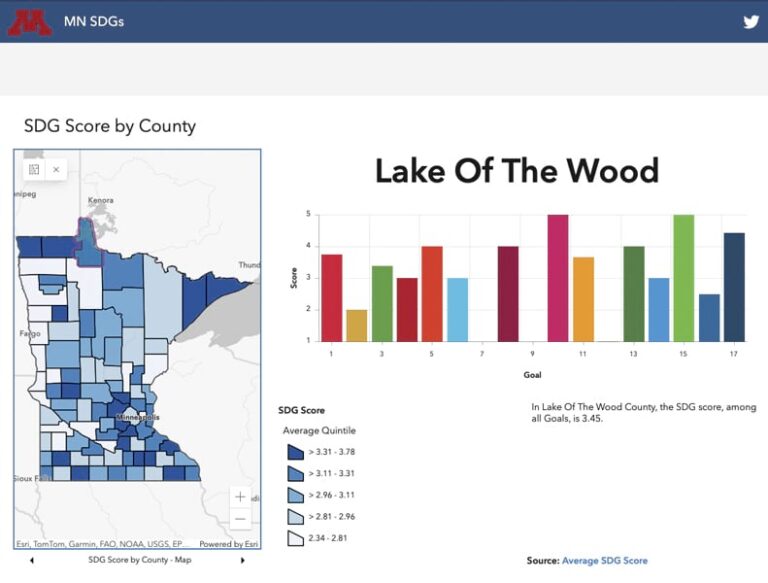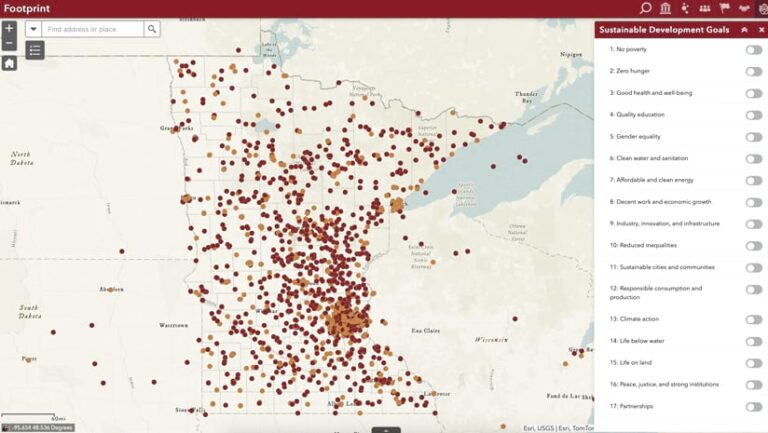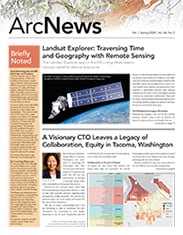The 17 Sustainable Development Goals (SDGs) adopted by all United Nations (UN) member countries in 2015 are as ambitious as they are sensible. Set out to help countries end poverty, protect the planet, and ensure prosperity for all by 2030, these interwoven goals include ending hunger; guaranteeing gender equality; and creating inclusive, sustainable cities while protecting land and conserving water. To eliminate poverty, for example, there must be access to gainful employment, clean water, quality education, and ample food sources.
Above all else, the interrelated goals are applicable to every region and every population in the world—including Minnesotans.
SDGs are a tool to help with the problems that we all face, said Katey Pelican, coleader of the University of Minnesota’s Sustainable Development Goals Initiative and director of the Strategic Partnership and Research Collaborative office in the university’s Research and Innovation Office.
Building a Statewide SDG Hub Site
The University of Minnesota—a public land-grant research university with five campuses, more than 68,000 students, and an international presence—has used the SDGs since 2019 as a framework for creating a more coherent approach to its work inside and outside the university. The university is the sole academic member in the SDG Data Alliance, a partnership of foundations, UN organizations, governments, and private industry—including Esri—bringing GIS technology to developing countries to speed SDG achievements.
“It fits us well,” said Pelican. “We’re a huge, decentralized do-gooder,” she said of the university system based in Minnesota, which itself has a culture of offering a helping hand.
The university created its own prototype, the SDGs in Minnesota hub site. Built by a team of several students and faculty members using Esri’s Sustainable Development Goals Solution released in 2022, the site shares relevant county-level data for help in decision-making, including showing where each county performed on the 17 SDGs. The hub site’s creators hope it will be replicated by universities worldwide, making it a catalyst for local action.

Bridging the Gap Between Goals and Local Action
Last year, as the SDG initiative was nearly at the halfway mark of its 2030 target, UN Secretary-General António Guterres warned, “Unless we act now, the 2030 agenda will become an epitaph for a world that might have been.”
Part of the problem, Pelican said, has been a wide gap between national goals for addressing the SDGs and local action. That’s where she hopes the university’s solution—its hub site—can bridge the gap as a tool that can support local efforts toward achieving the goals. “That’s ultimately our vision,” she said.
The SDGs have been woven into the university’s strategic planning since 2019. The hub site is part of that, boosting impact by using GIS tools to make information more accessible to more people. For example, the university has mapped the campus locations of its academic experts and indicated their research related to SDG goals. It has also mapped the university’s SDG work with the public, such as financial counseling for young mothers and outreach on residential clean-water programs.
Spatial thinking is another way to frame all this, said Len Kne, director of U-Spatial, the university’s research center for GIS, remote sensing, and spatial computing. “You’re talking about a place and people in that place and bringing all that together and using geography as the lens, as the filter, as the way of intersecting all of these different approaches and indicators,” he said.

Eventually, the hub site is expected to be used by local and state policymakers, organizations, and the public to measure and visualize progress. It will be a virtual place to facilitate collaboration on efforts, Kne said. It also recognizes that Minnesota, like other states, is made up of unique localities in rural or metropolitan areas, and that to address issues such as poverty, policy has to be addressed locally.
Pelican and Kne believe that their hub site can eventually be replicated by academic institutions around the world to foster local SDG implementation.
“We’re a land-grant university, so we’ve been focused on Minnesota as the prototype to show what’s possible,” Kne said, adding, “I think we’ll continue to focus on Minnesota, but it would be nice to expand more broadly.”
Hub Site Development Lessons
One of the university’s biggest challenges has been creating a uniform approach to data standards, indicators, and the metrics used to measure SDG efforts so that everyone is on the same page and communicating in the same language with consistent measures.
Universities can be neutral parties to help determine those standards and indicators. A state may be reluctant to make comparisons between its counties based on SDG performance. However, a university can evaluate SDG performance in a nonpolitical con-text. “We’re neutral, but we can also make observations and statements that the state cannot,” Kne said. “We can make comparisons between counties.”
The county-level data that Kne and his team have collected so far has come from ArcGIS Living Atlas of the World, US census data, the Federal Emergency Management Agency, state agencies, and university colleagues. The team also collaborated with the West Central Initiative (WCI) in Minnesota about what indicators it relies on. Working closely with WCI, a regional nonprofit foundation helping nine rural counties and a portion of the White Earth Nation in west central Minnesota to thrive, the university was able to deliver SDG indicators for its region. WCI has since embedded the hub on its own site.
Kne expects the hub site to always be a work in progress, since new and different datasets are coming online all the time.
He also hopes to automate the process eventually and incorporate subcounty data for cities and towns, “knowing that a lot of the change that happens in moving that bar with SDGs is going to happen at that local level,” Kne said.

